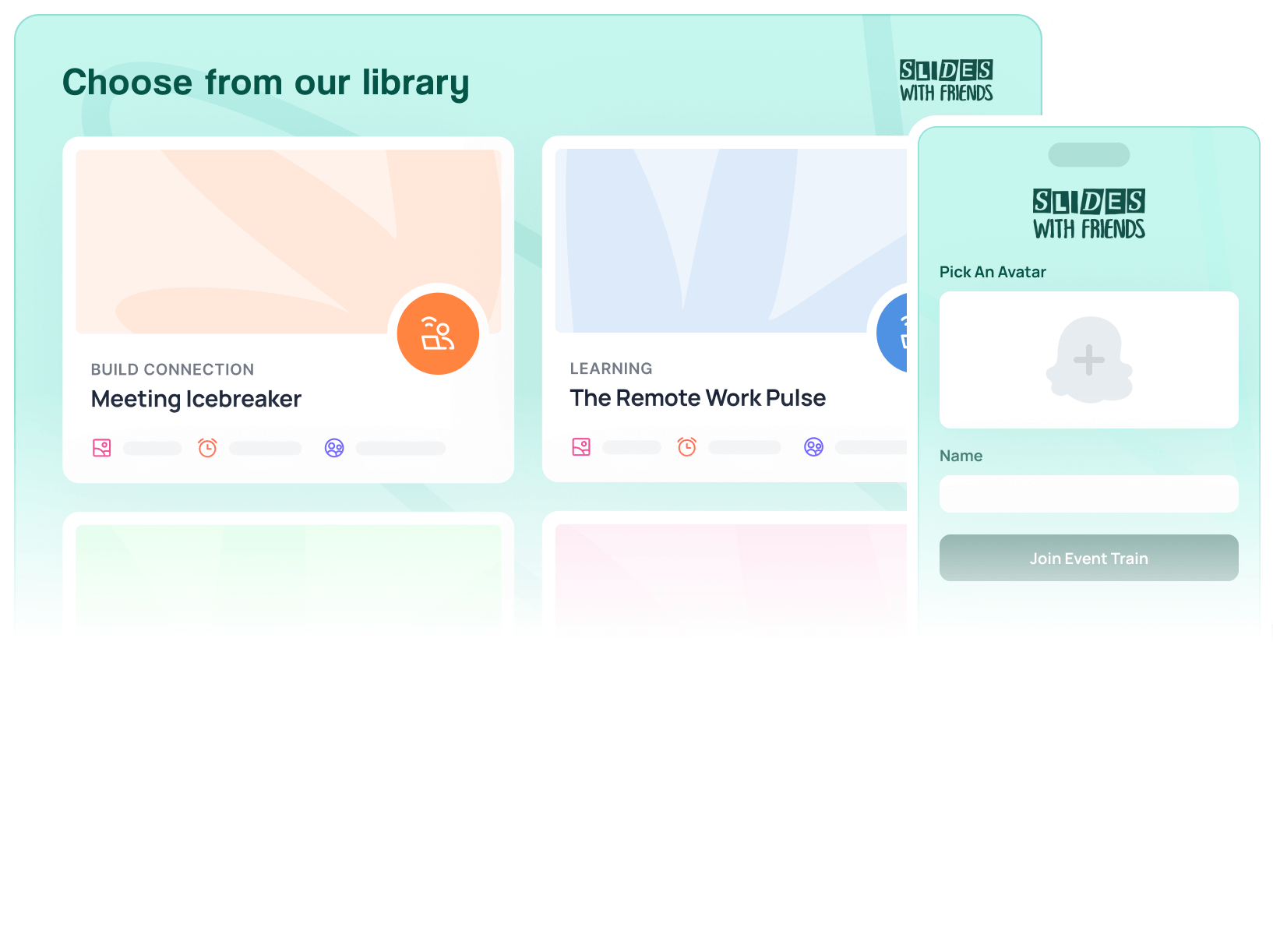The Best 5-Minute Team Building Activities (Virtual & In-Person)
In terms of employee unity, playing works. If you need to bring your remote team together (on a time budget) here are the best ten games for you!

It can be a struggle to keep your team connected when you're not all in the same conference room every morning. Spending five minutes before a meeting with an icebreaker, trivia game or social task can provide a team with the psychological safety needed to maximize innovation, productivity and overall performance.
We've done the legwork of sourcing some of the most fun — and shortest — games and activities you can play with your team before getting down into the work of the day. We paid special attention to games that are positive and socially connective, fun to play, and that give you the most team connection & camaraderie bang for your five-minute buck.
Here are the top team building games you can play in 5 minutes:
1. Quick Trivia Competition
A classic icebreaker game is a quick, simple round of trivia. Here's a ready-to-play 5-minute interactive trivia game:
This is a ready-to-play trivia that works like a slide deck presentation. Questions are added already, and the end will show you the winners automatically. You can also change the questions to be whatever you like to make it a perfect fit for your team.
Or, if you want to play it more analog and simply, you can create your own pen-and-paper version. Best practices for this include: Keep the questions unrelated to work and between 5-10 so the game can be played in under five minutes. Mix up the topics to include input based on the diverse interests of team members. Award points for correct responses based on the level of difficulty.
- Prior to the meeting, come up with five multiple choice or short answer trivia questions.
- Ask the questions verbally during the meeting or, for video conferences, share your screen with the questions typed on presentation software, such as PowerPoint or Google Slides. Or you can use an interactive trivia game maker as well.
- Award a point to the first person who responds verbally with the correct answer and keep score on a notepad. (Some applications, such as Slides With Friends, compile points for you and have participants submit responses on their smartphones so that all correct respondents, not just the first one, are awarded points.)
- Award two points for the third and fourth questions and three points for the fifth and final question.
- Add up everyone’s points and the player with the most points wins.
2. Ask 2-3 Icebreaker questions
This might be the simplest option — simply ask your team some ice breaker questions to get them warmed up, and go around the room or call.
Here's a great list of some of the best icebreaker questions you can ask. We created these questions with some important goals in mind, including helping your team connect with each other, be more mindful, and feel positively about one another.
Some good questions from that list:
- What's your favorite item you've bought this year?
- If you were famous, what would you be famous for?
- What's the best meal you can remember eating?
- What would be the best fictional world to live in?
- What's something nobody here knows about you?
- What's a book you loved as a kid that everyone should read?
- Who is your ultimate female role model?
- If we had an office talent show, what would be your talent?
3. Play a Mini team building game
Play either of these 5-minutes games to get your team talking and laughing together. To play, your group would just join in and send responses to the questions and games through their phones (no downloads or set up required). They're both free to play with up to 10 people.
Both games let your group build a word cloud together, ask them a silly icebreaker question, and then let them share a photo or two from their day.
How to play:
- Sign up for a Slides With Friends account (it's free)
- Copy the deck you want to play
- Press "Start Event" on the deck (think of it like an interactive PowerPoint game)
- Join in with your team and play together, advancing slides to move the game along
4. Pick-a-Penny
This is a favorite game of ours. It works great in person or remote, and it's super-easy to play.
Each team member grabs a coin out of a bag and explaining what they were up to the year the coin was minted, or what they would do if they could time travel to that year. You don’t have to use pennies; it can be nickels, quarters or even paper money with the issue date. Remote teams can improvise by choosing money they have at home. To make it competitive, see who is paying attention and ask how much money was presented during the game and the response that is closest to the correct amount wins.
- Ask each participant to select a coin from a provided bag or from their home.
- Take turns sharing which year each participant’s coin was minted.
- In order of oldest to newest coin, players take turns sharing what they were doing in that year (or what they would do if they could time travel to that year).
- Ask the entire group to guess the total amount of money used in the game.
- The person with the first correct guess (or the closest guess without going over the amount) wins.
5. Two Truths and a Lie
Perhaps one of the most used and popular team-building games is having each team member take turns sharing three fun “facts” about themselves: two things that are true and one that is a lie. The other team members have to guess which statement is a lie. Keep score by awarding a point for each player’s correct guess for a truth and the person with the most points wins.
- Ask each participant to think of two truths and a lie about themselves.
- Each participant takes turns sharing their “facts” without revealing which one is a lie.
- After each sharer is done, each of the other participants guesses the lie.
- The sharer reveals the lie and a point is awarded to each person who guessed correctly.
- The guesser with the most correct responses wins (break a tie based on the sharer who induced the most incorrect responses).
If you want to do a bit of prep work to make it a more formal or competitive game, and have displayed questions and official winners automatically tabulated, you can use a Two Truths and a Lie Interactive Template Deck from Slides With Friends to make your game interactive and official-looking. It's free to use with up to 10 players.
6. Emoji Charades
Many people have played charades, a game where a person is provided a word or phrase and they must remain silent and use gestures to get other team members to guess what it is. A twist for remote teams is using only emojis and having players submit their guesses with emojis from their phones. Some of the more than 200 emojis are easier than others, such as a peace sign or smiley face, but some of the foods and tools might literally throw a wrench into the game.

How to play:
- Prior to the meeting, choose enough emojis for the amount of participants and assign them a number.
- Once the meeting starts, ask participants to choose a number and send them a text message of the corresponding emoji assigned to the number.
- Each participant takes turns acting out their emoji using only facial expressions and hand gestures (ask them to be muted if you’re using a video conference) while the other participants try to guess the emoji.
- Set a timer for two minutes and the first participant to correctly guess the emoji is awarded a point; deduct a point from the actor if either no one guesses correctly or the actor says any words aloud.
- Add up everyone’s points and the player with the most points wins.
7. Virtual BINGO
As recommended by Sean McPheat of Management Training Specialists, create a 3-by-3 grid and within each square list something that the participants could have done. Reveal the items for each square one by one and the first people who match three in a line, or a BINGO, gets a point. Items can include “Went to bed after 11 p.m. last night,” “Visited the beach last summer,” or “Has a tattoo.”
- Using presentation software such as PowerPoint or Google Slides, create a slide with a 3-by-3 grid and for each subsequent side fill one square of the grid with a description of an activity that someone could have performed recently.
- Ask participants to draw a 3-by-3 grid on a piece of paper and place an X on the grid corresponding to each activity they performed as it is revealed on the screen by the advancing slides.
- The first person to have three X’s in a row (horizontal, vertical or diagonal) wins. If no one has a line or there’s a tie, determine the winner by the most X’s.
8. Memory Game
You have emojis and you have a BINGO grid, now combine them to create a memory game by testing the recall for individuals or the collective efforts of an entire team. Arrange emojis on a grid before revealing and then hiding the emojis in each square. Then ask participants to recall which emoji is in each square. You can increase the difficulty with larger grids or remove the grids altogether and try a sequence game. In World Memory Championships, competitors do this by memorizing the order of a shuffled deck of 52 playing cards. But you can try a sequence memory game by simply asking participants to recall the images on five consecutive slides. Keep advancing more slides and see how far you can go before someone forgets the correct order.
- Using presentation software such as PowerPoint or Google Slides, create a slide with a 3-by-3 grid and for each subsequent side display an emoji in one of the quadrants.
- After all nine emojis are revealed on the grid, return to the slide with the blank grid.
- Ask the group to recall what is in the first square, second square, and so on, and advance the slides after each response to reveal the correct answer.
- Whoever guesses the most correct emojis wins.

9. Word Blurt
This is a simple word-association game that is played by having a word or image displayed on the screen and letting participants say the first thing that comes to mind. You can play an interactive version using a Slides With Friends World Blurt Interactive game deck, or do it the old fashioned way.
This game encourages people to think on their feet and be spontaneous. Develop the game further by asking team members to take turns adding another word, within five seconds, to see how far the team can go to tell a coherent story.
- Before the meeting, come up with five randomly selected words (or images if you are using presentation software).
- Once the meeting starts, ask participants to say the first thing that comes to mind upon hearing the word or seeing the image.
- Take turns, assigning one person per word/image before it is revealed, or allow all participants to blurt out their responses as the words/images are presented.
- Bonus: take turns having each participant blurt out another word or phrase to form a coherent story. For example, player one: “Cat,” player two: “Scratches,” player three: “Your back,”player four: “In time,” back to player one: “Then suddenly,” and keep going until someone can’t think of something to say after five seconds.
10. “Take a Picture of Your Shoes”
This is a favorite of Sutherland’s, which she credits to Lucid Meetings. Ask team members to take a picture of their shoes and submit it with their phones for everyone to see. According to Chris Higgins of Lucid Meetings, people are surprisingly willing to share their shoes and it sometimes reveals their hobbies and interests. To make more of a game of it, ask people to guess whose shoes belong to whom or send zoomed in images and have people guess the type or brand of shoe.
- Ask participants to immediately take a photo of their shoes with their smartphone and send it to the meeting host.
- The meeting host then takes turns randomly displaying the photos, either on their phone for in-person meetings or screen sharing for video conferences.
- The group then guesses either the type of shoes or whose shoes they belong to.
- After the correct guess is made, the owner of the shoes tells a brief 30-60 second story about the shoes (where and when they purchased them, why they like them, etc.).
11. Pictogram Riddles
Pictograms riddles, which are pictorial symbols that represent a word or phrase, are great for team-building games because people can work together or at least see how others see images differently to solve problems. Here’s a version using bottle caps that's pre-made and ready to play with interactive questions: Puzzle Masters interactive game deck.
Or you can source the questions yourself and set up the game manually:
- Before the meeting, come up with five pictogram riddles. For ideas, search the internet for “pictograms” or “rebus.”
- Present each pictogram using presentation software, such as PowerPoint or Google Slides, and give the participants 1-2 minutes to come up with the answer.
- Award a point to the person with the first correct answer to the riddle (or none if time expired) and reveal the correct answer.
- Repeat until all pictograms have been displayed and the person with the most correct responses wins.
12. Photo Show and Tell
This game is played with photos or items at home. Team members are given prompts, such as "What's the most interesting item you can reach from where you're sitting?" or "What's the most fun you've had recently?" For each prompt, three submitted photos are displayed at random, allowing the submitter an opportunity to show off to everyone and talk about it. To make it competitive, have the team leader ask questions at the end, such as “What’s Nancy’s main weekend activity?,” to see who was paying attention and award points for the first correct answer.
Here's the photo show & tell deck, free to play with up to 10 participants:
It's easy to play, just copy the deck into a Slides With Friends account, and launch your event like you were launching a PowerPoint presentation. Advance through the slides, send in photos, and display them one by one.
You can also do this in an analog style:
- Before the meeting, come up with three prompts, asking participants to respond with an answer or a photo.
- Present the first prompt, either verbally or sharing your screen for video conferences, and take turns asking participants to respond, giving them up to two minutes to speak.
- After everyone has responded, present the next prompt and repeat step 2.
- Repeat until all participants have responded to all the prompts.
Why Playing Team Building Games Works for Organizations
Games help flatten organizational hierarchy, encouraging input from all team members and rewarding vulnerability. Because games are lower stakes than actual work and everyone is on a level playing field, participants can avoid anxiety responses to social situations and instead become freely engaged as contributors and collaborators on their team.
These days, engaged employees are harder to come by (only 36% according to a Gallup poll) and more teams are becoming physically dispersed because of a preference for remote work (81% of employees enjoy remote work and 82% of company leaders would allow remote work at least some of the time). Especially for remote teams, team-building games and icebreakers help make up for a loss of three major benefits from teamwork: community, interaction and empathy. To some, these activities might seem hokey or like a frivolous way to spend time, but they can provide a huge return on investment.
“Despite its reputation for being, well, lame, team building is the most important investment you can make for your people,” wrote O2E Brands CEO Brian Scudamore in Forbes Magazine. “It builds trust, mitigates conflict, encourages communication and increases collaboration. Effective team building means more engaged employees, which is good for company culture and boosting the bottom line.”
It also helps with communication skills — communication skills being one of the most important things your employees can have when interfacing with each other.
Why Playing Games Works for Employees
In an interview with The Cut, psychologist and management consultant Anton Villado said a well-done icebreaker or team-building game ...
- makes people less nervous about being in a new situation,
- sets the tone for what to expect from a meeting and
- encourages people to talk about themselves.
Giving everyone a chance to speak is crucial for a successful meeting, according to Lisette Sutherland, the director of Collaboration Superpowers, a company that facilitates remote workshops.
“That’s very important because research shows that if a person has spoken once during the meeting that they are more likely to speak again,” Sutherland said on her company’s podcast. “(Even if it’s) just the opportunity for everybody to go around and introduce themselves with a favorite question like favorite food, favorite holiday place (or) favorite smells.”
While prompting people with questions is effective for team building, researchers have found that social games are better than social icebreakers when it comes to building trust. Either way, it’s important to keep games and icebreakers easy to understand and able to be completed within five minutes so that the team can get to the business agenda of the meeting.
Now go out and play!
Whichever type of game you choose, make sure each team member has an opportunity to speak or contribute. If one or two people are doing all the interacting, the team is only seeing their perspectives and empathy and trust can be lost. Remember, building community among a team takes time; don’t waste any more time trying to explain a complicated game. Keep it simple. Play games that people are either familiar with, like charades or BINGO, or with easy to follow instructions, such as trivia or Show and Tell. But most of all, have fun!


Ready to ditch the dull, and run team sessions that people will actually enjoy?
Get started with a Slides with Friends deck in no time. We’ve got all the interactive features you need in one easy-to-learn, easy-to-set-up tool.















